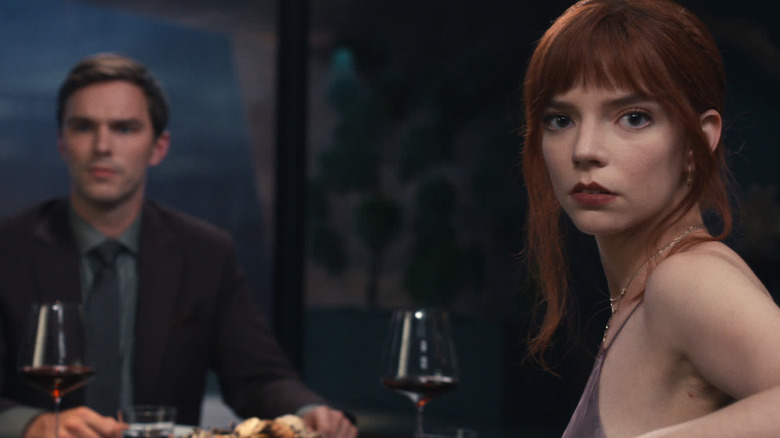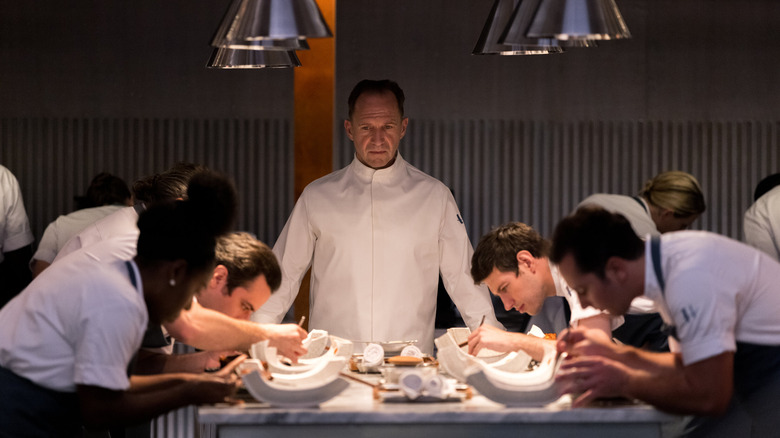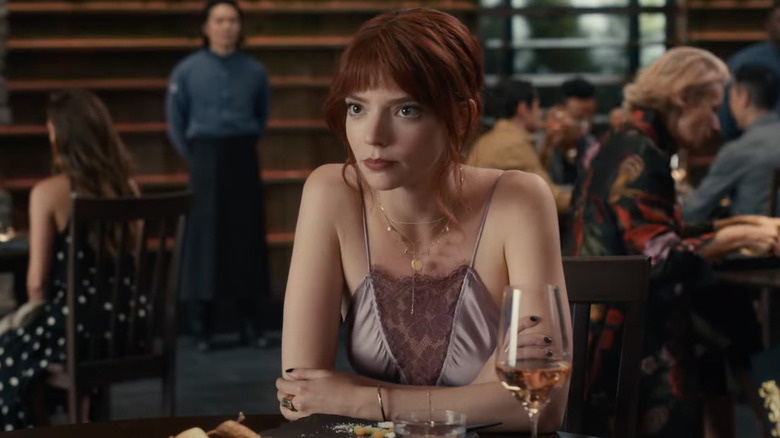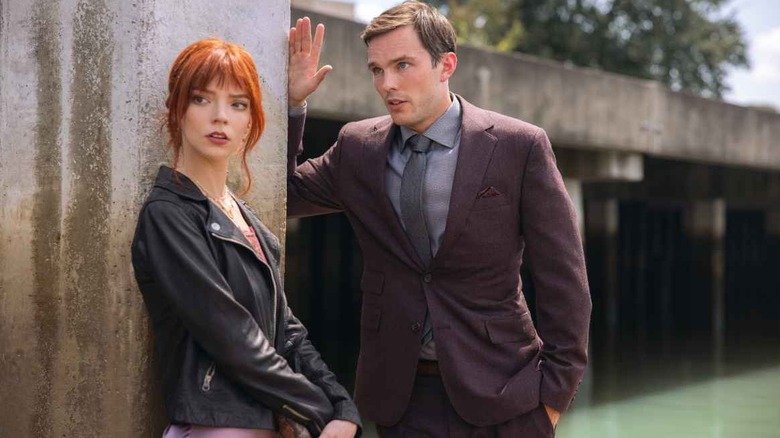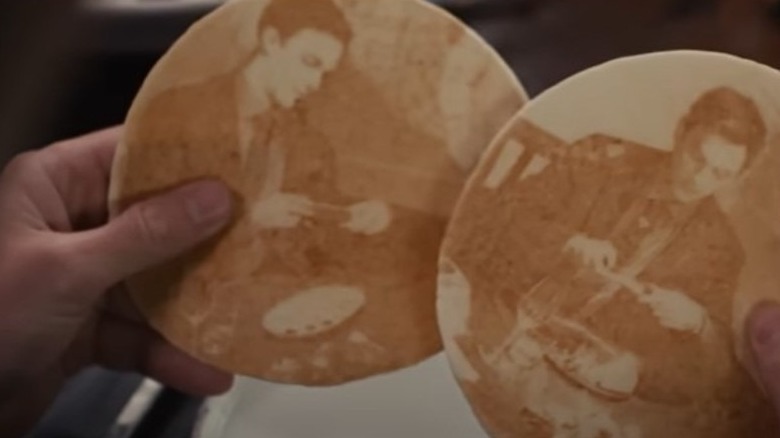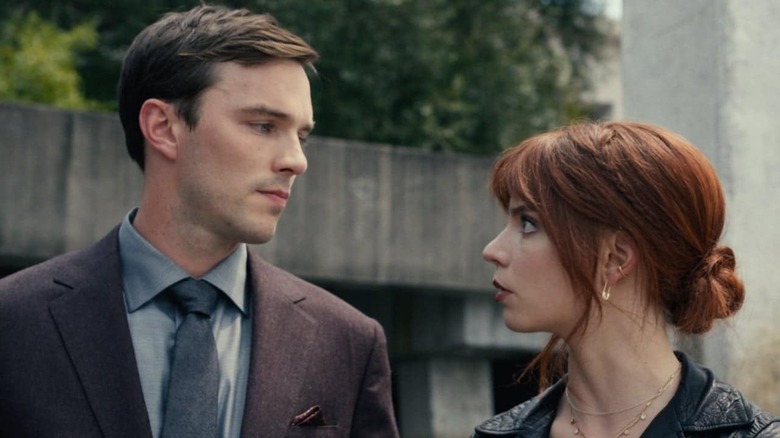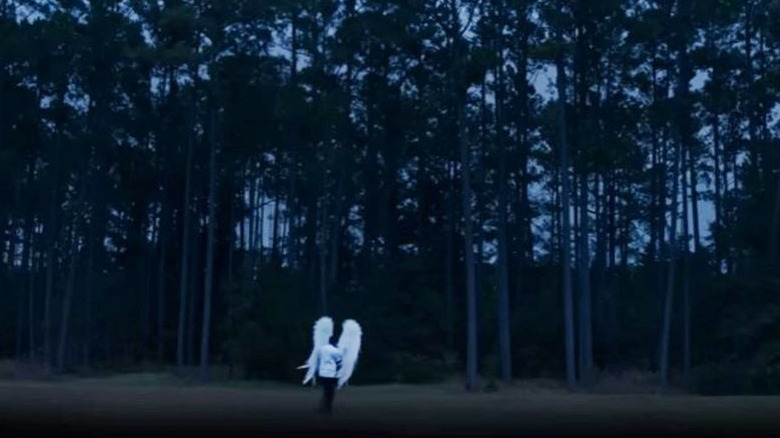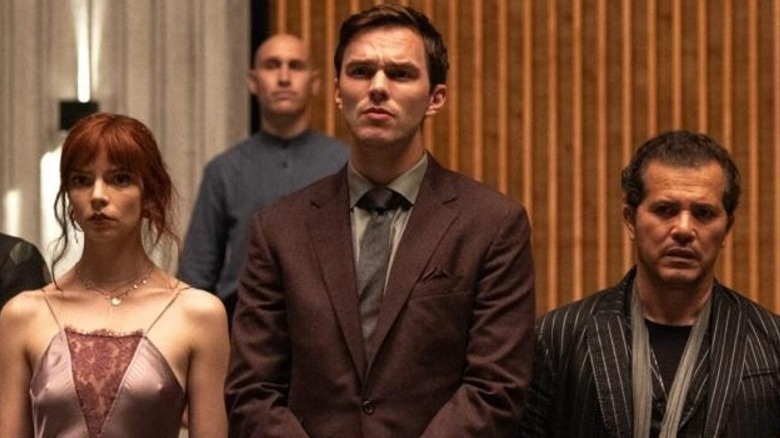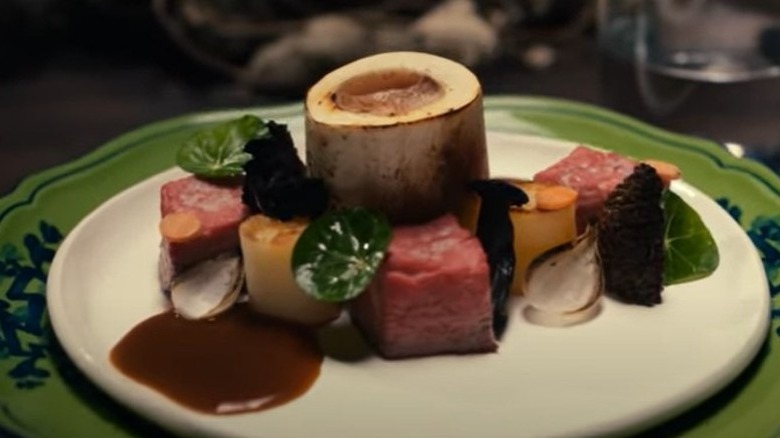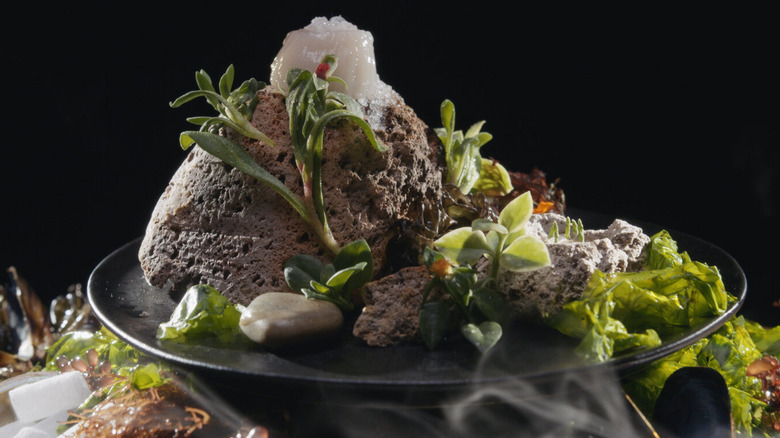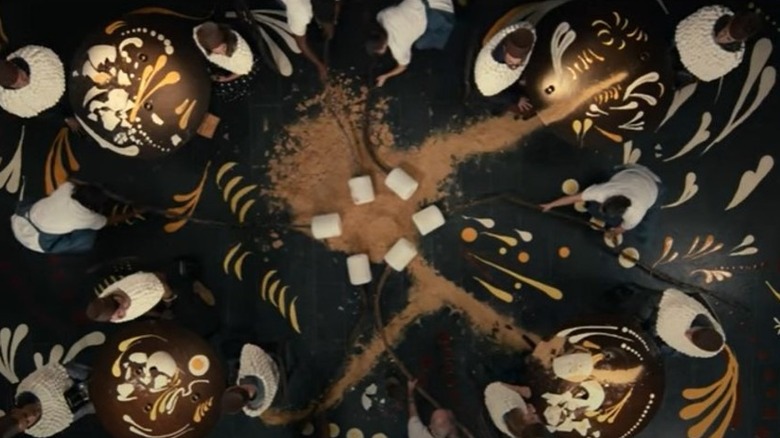The Most Chilling Moments In The Menu, Ranked
Warning: The article below contains major spoilers for "The Menu."
Director Mark Mylod ("Shameless," "Succession") has made a career off of crafting class-conscious comedies that bitingly remind audiences of the absurd lengths people travel to obtain status, wealth, and social clout. "The Menu" serves a similar dish to viewers but with a darker, horrific bent. Although Searchlight Pictures defines the film as a horror comedy, prepare to experience more vengeance than ridiculous boardroom hijinks.
While on the surface — and in the film's opening minutes — the ensemble cast feels like they all own stock in Waystar Royco, harrowing cracks to their sardonic personas emerge soon enough. The terror here isn't learning that these characters, for the most part, are entitled, catty, and impossible to please. What's chilling here is watching the razor-sharp pacing of "The Menu" lead these characters into confessing they've always known who they are and the terrible things they've done: They've just chosen to look the other way because they can.
Not anymore! If you're a horror fan with a taste for bloodshed on-screen, you won't go home disappointed, though it's not a film that prioritizes gore over substance. To Mylod's credit, even tense, close-ups of quippy dialogue can send shivers down your spine. Revealed secrets will scare audiences more than any bodies we see covered with white linen. Here, I'll explore how each course of "The Menu" meticulously captures terror and why it's effective.
The breadless bread course
Ah, the breadless bread course. In "The Menu," this is the first moment where the diners of Hawthorn, an exclusive restaurant run on a private island, realize something feels off-kilter. Guests who have eaten here before, like Anne (Judith Light) and Richard (Reed Birney), intuit that this $1,250 (per plate!) dinner is different. However, they conceal their discomfort by laughing it off and assuming he's playing into a gimmick when they receive a plate of sauces with no bread to eat.
Although they don't understand it yet, this tongue-in-cheek course depicts Chef Julian Slowik's (Ralph Fiennes) growing animosity toward his elite guests. They don't know if they're a part of the joke or its meaty satire. Fittingly, only Margot (Anna Taylor-Joy), the escort, realizes that he's "f***ing" with his customers. Everyone else, including the food-obsessed Tyler (Nicholas Hoult), reveres the chef's action, explaining that his removal of bread — which he calls a peasant's food — is a compliment.
The guests' inability to believe someone would dare exert power over them is mind-boggling. At this point, you realize that none of them, except Margot, are the kinds of people who will survive a horror movie as they believe they're untouchable. In reality, they're trapped, defenseless, and underprepared to fight for their survival, making this scene the visual equivalent to a plucked violin string in a James Wan film. The dining room becomes a cage in itself for horror to thrive.
Margot's bathroom confrontation with Chef
What works best about Ralph Fiennes' and Anna Taylor-Joy's dynamic is it's not as simple as their characters playing a cat-and-mouse game. Neither of them is a mouse. Chef and Margot are equally calculating and come with a long resume of serving other people's needs and being in a customer-focused position. What exists between them is the kind of mutual respect and tolerance that exists between those working in the customer service industry. When Margot doesn't eat Chef's food, he becomes even more intrigued by this unplanned guest.
Still, his way of addressing her arrival and dislike for his pompous attitude at dinner is chilling. Of all the places to speak with her, Chef follows Margot into the bathroom. She's alone. They're far enough away from the dining room that anything could happen, and no one would reach Margot in time. Ultimately, their conversation is one of many bloodless tête-à-tête moments in "The Menu." But that doesn't mean scriptwriters Seth Reiss and Will Tracy deserve any less credit for the tension it wrought. Sometimes writing a suggestive and claustrophobic scene carries more narrative weight and prepares us for darker realities to come. This scene not only teases us with the potential of violence but it's a telling character moment. Chef is willing to invade Margot's personal space to get his answers. We can't help but ask: How much farther will Chef go with his guests? Oh, if they only listened to Margot!
Katherine's course, aka run, men, run!
Narratively, Katherine's (Christina Brucato) course arrives after more unsettling moments have already happened on screen, like the sous chef's (Adam Aalderks) brutal death. Although it had wonderful potential, it stops short of what it could have been. Ultimately, it was missing one or two more harsh moments to keep up the film's precise pace and tension.
However, its chase scene setup still contains a fantastic idea. Outside, Katherine reveals a spine-tingling truth: Chef Julian not only sexually harassed her at work but went eight months without acknowledging her existence on this private island (immature, much?). She then stabs Chef below his belt (you can guess where) and tells all the male guests to run. Fellow chefs then chase after them as they hide from the knife-wielding cooks.
While hearing Chef apologize to Katherine and watching her stab him was compelling, none of the other misogynistic male guests received that comeuppance. No one loses another finger or toe when it feels like the most logical place to slip in some light slasher mayhem — similar to how "Ready or Not" doled out cathartic jabs. Instead, they escape unharmed, and the remainder of the scene puts us in the room with the women who realize everyone will likely die tonight. That was also Katherine's idea, which doubles her delicious revenge prowess and reminds us all to never mess with the people who prepare our food.
If you or anyone you know has been a victim of sexual assault, help is available. Visit the Rape, Abuse & Incest National Network website or contact RAINN's National Helpline at 1-800-656-HOPE (4673).
The memory course
By the time Chef serves tortillas with the faces of his dinner guests laser-printed on them, the audience knows he has something dark up his sleeves. But this is the first time we have a bigger sense of the life-or-death stakes at play. Michelin-starred chef Dominique Crenn crafted all the delectable food we see in "The Menu." Her tortilla creation reveals to the audience that Chef Julian has not only been keeping tabs on his guests throughout the dinner — including Tyler's annoying habit of photographing everything he eats, despite being told not to do that — but for years. Julian knows just which restaurants closed due to Lillian's (Janet McTeer) scathing reviews. He knows which offshore accounts from the party bros contain stolen funds. When we see the detailed depth Chef Julian has gone to call out his guests for their indiscretions, we know that punishment must be coming soon.
Unlike prior courses, this one demonstrates how much time Chef Julian invested in researching his guests before killing them. Without details like this course, you could say that Chef Julian "lost it" and committed murder due to being incredibly burned out. Yes, he's burned out and resents his guests for turning him into someone who serves people "like them," but this scene proves this is a premeditated murder spree. Thinking about how he was patiently plotting this dinner as he cooked for others brings more terror than what we've seen on this list thus far.
Tyler's bulls*** course
For some readers, this scene will likely rank way higher on their lists of the most chilling moments in Mark Mylod's film. However, I detested Tyler (thanks to the script) so much that it felt hard not to be gleeful at exactly how Chef Julian serves up Tyler's punishment. As someone who has worked within kitchens before, I can tell you that they're not like "The Chef's Table" world Tyler imagines these rooms to be.
It's more like this: ticket orders seem to multiply in a blink of an eye. Seat 39 wants more ranch sauce even though we do not have ranch sauce. The line precariously holds dishes, and there are 30 seconds or less to deliver them to the proper seating — but your medium rare steak is nowhere to be found. A careless hand wave ends in yet another burn on your arm. But when that swinging door opens, you must let go of your pressure-cooked brain and embody poise and stretched-thin smiles. We see this same livewire act play out across the strict kitchen in "The Menu."
For me, having Tyler beckoned into the kitchen by his idol and miserably failing at cooking felt more comedic than scary. Of course, this foodie would have no idea how to cut a shallot! Still, the way he dies is harrowing. We'll never know what Chef Julian whispered to him but it couldn't have been good. Afterward, Tyler dies by suicide, making it hard not to wonder if that was Chef's command.
If you or anyone you know is having suicidal thoughts, please call the National Suicide Prevention Lifeline by dialing 988 or by calling 1-800-273-TALK (8255).
Angel investor intermission
Sometimes a quiet death in horror brings more terror than an elongated torture scene. Yes, this kill sequence is a little on the nose — Hawthorn's angel investor is wearing angel wings — but the cinematography here is gorgeously dark. After Chef Julian announces that he'll kill the investor, floodlights turn on to show the guests that the financier is hanging on for life by a thread (literally). He's being dangled above the ocean, begging for his life.
But the restaurant has soundproof glass so we can't hear a thing. We have no idea what he asks for in his final moments. Instead, his body becomes slowly submerged in water until we can no longer see him on the screen. Almost, it's as if he was never there. The camera lingers on the still water for just long enough before cutting back to Julian's smiling face.
Why this ranks higher than other moments is simple: This was the one person who could have legally and financially stopped Chef Julian. In his mind, his backer's death grants him freedom. From this point forward, the guests know he's a killer who shows no remorse. Finally, they're aware they're trapped here and are in his murderous, experimental domain.
Tyler's psychopathic reveal
Of all the revelations in this film, Tyler's confession brings me the most terror. I can't decide which is a scarier truth about him: Is it that he knew everyone would die and still came to this twisted dinner experience? Or is it how callously he informs Margot that he knew she'd die before booking her as an escort? Mostly, it's the latter that sucker-punched me. Tyler tells Margot this so casually and mid-bite without thinking about how she might react to being called body fodder. He essentially sees her as his property since he paid for her time. (Whoever broke up with this man-child to make room for Margot at Hawthorn was damn smart!) Appropriately, Margot nearly leaps across the table to rip his head off. But as we know now, the Chef has a much more fitting way to destroy him.
Still, Tyler's coldness and complete detachment from reality are haunting. The more you think about it, the creepier it gets. Did his girlfriend even break up with him? Does he have a habit of booking escorts, and if so, has anyone else died for his pleasure? Again, the film's impeccable powers of suggestion make this one scene linger in the viewer's mind. However, we never see Margot and Tyler really confront each other, which would have given this moment more lasting power. (I suggest Margot stab his "mouthfeel" with a fork.)
Sous chef's course
Of all the deaths in "The Menu," this one is the hardest to watch unfold. Likely, audiences won't see this one coming as the scene opens as it did with prior courses. Chef claps and then announces the next dish. But this time, it's his sous chef's dish. As he tells this to his guest, he also confides in them that Jeremy will never be a great cook and he knows that, too. Jeremy grimaces but agrees to that fact. He then shoots himself before being laid out on white linen as if he too is a plated course. His dish is a spin on a bone marrow plate.
Visually, it's a stirring metaphor for how we consume artists. We demand more and more from them without thinking of the toll it takes on their mental health, especially when it comes to chefs. His choice to serve bone is particularly haunting as it reinforces this concept of giving everything to a dish. As a viewer, it's hard to imagine anyone biting into meat while seeing the staged body in front of them.
The only drawback to this scene is we seldom see this character in the film, minimizing how much we care about his death. Now if Elsa (Hong Chau), the film's wittiest character, died in that scene instead, it'd easily earn a higher spot. Still, its quickness and choice to linger on the guests' processing of what happens will send shivers down your spine.
If you or anyone you know is having suicidal thoughts, please call the National Suicide Prevention Lifeline by dialing 988 or by calling 1-800-273-TALK (8255).
Margot sends her food back
Crenn designed the food in "The Menu" to possess an element of death. These beautifully plated creations aren't Crenn's work but the fictional Julian, a man at the end of his rope. Of course, his craft reflects his deteriorating mind. Garnishes subtly wilt, and even the moussed meat looks grey. Julian lost his desire to create, so each plate arrangement has muted colors, representing his strained relationship with cooking. To reject the food here is to rebuff what remains of Julian. By the film's end, Margot realizes this and uses his dissatisfaction to save her life. Despite seeing his mercurial nature — like Tyler's unplanned death — Margot claps at Julian and asks to send her food back to the kitchen.
What unfolds next is a masterclass in line delivery, as their sparring words feel like barbed wire. Although the moment eventually leads to gifting Julian with remembering the joy he once had in satisfying customers with his craft, it's easy to assume their exchange erupts in a final act-style, bloody conclusion. Instead, we nervously watch Margot's fine-dining rebellion: She asks for a cheeseburger. When she bites into it, the shot zooms in, suggesting how she reacts will fundamentally change the plot, and, it does! Her daringness to connect Julian to his craft again grants her freedom before the film's grand and disturbing finale. No one else had the nerve to challenge Julian, granting Margot the second-highest spot here.
Deconstructed s'mores scene for dessert
Deconstructed food in restaurants can sometimes be silly (like when I saw a deconstructed PB&J: a cutting board with a dab of jelly, a spoonful of peanut butter, and crackers for a whopping $15). Still, there is an art to breaking free of food conventions to make something refreshing. In that light, it's almost bittersweet to end this killer experience with dinner guests becoming deconstructed s'mores. Splashes of (highly flammable) marshmallows and emulsions are meticulously rendered on the dining room floor that we get to see thanks to the film's overhead shots. While the chefs quickly accent the floor with floral swirls of sugar, the score has a giddy speed.
The camera returns to his guests, wearing marshmallow hats while the inevitable flames erupt. We don't see the charred bodies, but there are enough details to imagine the smell. Hearing those about to die a Jim Jones-style death thank Chef Julian for the experience is the most chilling part of this entire film. Throughout Julian's courses, he stripped back layers and layers of his guests' guises. That was the story he had to tell, his act of "love." He broke his customers into cheap, sugary treats, essentially calling their lives a quick flash in the pan as, unlike Margot, they have no other substance to their character. Only he and the chefs will appreciate their ironic death, as they designed the entire evening to be. This ending takes the cake.
